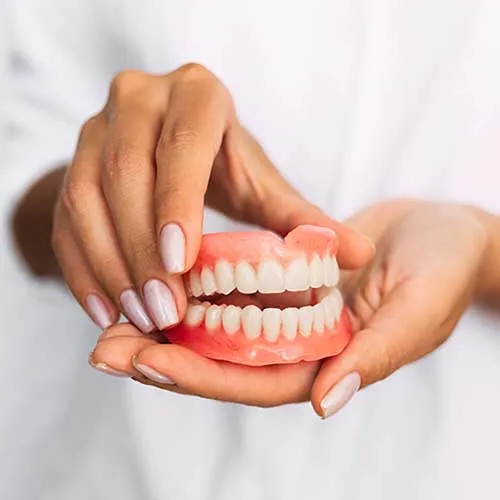Dentures
Dentures are commonly known as "plates" or "false teeth", are oral/dental prostheses that replace missing teeth. At Smiles, we offer comprehensive denture repair services in Edmonton to ensure your dentures remain functional. Whether you're dealing with minor cracks or more significant damage, our team can handle all types of denture repair needs in YEG. Regular denture maintenance is also essential to extending the life of your dentures and keep them fitting perfectly.Book Your Appointment

Meet Our Edmonton Denturist
David Ho, a veteran denturist at Smiles Dental Group, graduated from NAIT in 2006 and has over 15 years of experience in the field. He brings a wealth of knowledge and dedication to patient care, having served countless patients throughout his career. Outside work, David enjoys cooking, making homemade ice cream, and spending time with his family in Edmonton.
How Do Dentures Work?
How Long Do Dentures Last?
- If you are handling your dentures, make sure you are doing so over soft padding like a towel, if they fall onto a hard floor or counter they could break.
- Make sure the dentures are kept moist, never leave them in an area where they could dry out and warp. If you do take them out for a long period of time, make sure to stick them in a full glass of water, the dentures should be completely submerged.
- In the morning before you wear your dentures, be sure to brush your gums and palette, this will help get rid of any acids or bacteria from your daily food intake.
- Also brush your dentures directly before inserting them into your mouth to help keep them clean.

How Many Types Of Dentures Are There?
Fixed Dentures
These are implant-supported and require surgically placed implants. The denture is fastened to the implants with screws. The implants themselves are placed in the jaw bone. Fixed dentures are typically made out of the same acrylic as removable dentures, but can also be made out of zirconia, porcelain, or metal fused to porcelain. The latter is also considered a full-arch implant-supported bridge.
Removable dentures
These are the most popular and most common types of dentures. When most people think of dentures, they are most likely to be thinking about removable ones. There are multiple kinds of removable dentures.
Complete dentures
A set of complete dentures will replace the upper AND lower teeth. The upper denture is usually more stable and retentive because it creates suction with the roof of the mouth, and covers more surface area. The lower denture is horseshoe-shaped, and gets dislodged more frequently, and is more unstable during function (chewing, talking, etc.).
Partial dentures
Partial dentures replace one or more of the teeth in an arch and are anchored by the surrounding existing teeth in the same arch. Partial dentures can be made out of acrylic, or metal and acrylic.
Implants – retained complete dentures – these involve two or more dental implants which provide retentive support by allowing the denture to ‘snap in’. The mechanism usually involves a male cap that is attached to the implant and protrudes from the gums which snaps into the female housing in the denture. There are also cases where a titanium bar may be incorporated.
Hybrid partial dentures
Involves a removable denture that utilizes existing natural teeth AND implants to retain and stabilize the denture. These types of dentures are particularly useful when most or all the missing teeth happen to be on only one side of the arch. In this case, the implant(s) can be used to support the denture on the side with fewer or no teeth.
